How to Be a Painter I

Look: you have to have complete understanding of when your hand is heavy handed, and when it is light. What that feels like, and how to hold the brush. Sometimes though you need to be heavy handed and sometimes light and you need to know that too. How to be able to hold the brush so lightly that, any lighter, and you would drop it. How to hold the brush firmly and yet, still allow it to have give - to feel the push and pull of the canvas on the brush as much as the hand that seeks to drive it.
You should know how to dip your brush in the water so only a millimeter of it’s tip is submerged but pull it out quick so it only has one drop of water on it. If it has two, you will know before your brush even touches the canvas, so flick it aside with just the quickest and limberest flicks of the wrist, and the extra drop of water will fly away and not defile your painting and create a headache and drip down below you onto that perfectly and profoundly finished sky. And you must be able to do that in a split second because, thought you need a touch more water, you have no time to look away from the painting because it is all happening there. The flower pot is becoming, the sky is opening, the waters are parting… the god of all of your gods is arriving and you can’t miss it for a second.
How to be a Painter II

No one can tell you how to be a painter, that's for certain. Better not try and figure it out either. You just have to do it. How do you breathe? Who taught you? How do you blink or how does your heart pump? Likewise, being a painter is just like that. It comes. Naturally.
Burnt Sienna and Raw Umber are two great colors to mix with just about anything. It seems like, after you play with them for a while, that our entire world is made up of those two colors in conjunction with everything else.
How to be a Painter III

It’s quite simple really – you just pick up the brush and you start. But when to start? Start before you get caught up elsewhere, before you get distracted, before the computer phone doorbell cat dog moth flies in your ear and whispers that there is something so important to do and is somewhere else and you had better do right fucking now. There will always be that thing that needs to get done right now. I’ve got a thousand of them, at least. And they get done, one by one. Always. Trust me. So forget about it. Just for a little bit. Let it pass through your mind but don’t engage it. It will be there when you get to it. If need be, keep a piece of paper next to you while you paint and if you think of that thing that you had better do, write it down! Then, when you are done painting, take a look there and, if you see what you need to do, then do it! In the meantime, engage the image, the paint, the lines and circles, the gradients and textures. Let yourself become immersed in it. If even for just a moment you forget about all else, and you, the rhythm of your hand, the color on the brush, the way it lays upon the canvas, the way you stand there, with your head cocked slightly – if even a millisecond a space is allowed to open between thought and thought and awareness creeps through, catches a glimpse of the YOU of all Yous – then you might want to consider the night a success. But if that thought stream doesn’t pause, doesn’t cease it’s endless I Me Mine then what are you gonna to do? I’ll be honest- some of my sweetest work came about when I wasn’t looking. When I suddenly noticed I wasn’t looking, wasn’t really paying attention to what I was doing, was in the groove of thought, of music, of poetry if rhythm… even then… it is all the same river you see- the thought stream, the vision, the glimpse of You, the wide open long-range vista of Awareness with a capital A, the pain in your lower back from bending over for so long, the kink in your neck, the thought once again of all you really must need go DO. Yet, in the storm of all of that - of the grinding political storm - keep your hand supple- almost drop the brush all the time, allow it to rest there but don’t grip it, a gripped brush has no give. Every ounce of you ought to be like the fabled reed in the wind- making music in the river of breezes. Know when to change colors- when to add some purple, some magenta – the deep magenta, not the light magenta. Know why you are doing so. Be true to your color palette of choice- if you are going for earth tones- go with earth tones! But if a dash of light magenta or bright turquoise wants to step in and add itself- check it at the door, make sure it has an invitation. Intuition is the gate keeper here and if Intuition says c’mon in, then by all means Let It! You might be surprised the spice it might add to the party on the canvas. That's the funny thing about painting, about creating, about life- intuition is the gate keeper but there is another who would seek to wear that mask although it wears that mask beneath many others and it has a penchant for turning everyone away.Ultimately, it is only known as Fear. It is Illusion. It is the fear of being wrong, of making a mistake, of being too much or too little, fear of everything, fear of nothing. Fear that the magenta is a fools color and not to be taken seriously. Fear that your parents never liked turquoise. Fear that your loved one might come in behind you and say “WTF?! Lemon Yellow eyes?” Cause they just might. But intuition, especially if it’s been given a chance to stretch it’s wings, will never steer you wrong. Go with it. Trust me. Trust it. It’s like riding a bike. Of course, those first few times of riding that bike were a bit unsteady. So were, sometimes, those first times of trying to discern which was the voice of intuition and which was otherwise. One moment you’re listening to the Guiding Light, the Chief Principle, the next moment the voice of fear has shoved it’s way into the game and is wearing a mask that looks suspiciously similar but… So watch your mind! Watch where it leads you. It is not your mind that paints. Nor is it your heart. Nor your hand. Your whole being paints. By being the whole being, by letting your big toe paint, the tip of your ears, your breath- then you can truly realize the vision you seek. So you paint and grab those colors and splash them upon the canvas in well mannered daubs and violent eruptions. You watch lines form, and follow their curve, zigging left when it need to go left, zagging right when the time is right. Such is life.
But then you stop and you stop before your colors become mud, unless mud is really what you are after. And if you weren’t after mud but they became that anyways- who cares? There will be another chance, another time to paint. Another chance to coax diamonds from that mud.
How to be a Painter IV
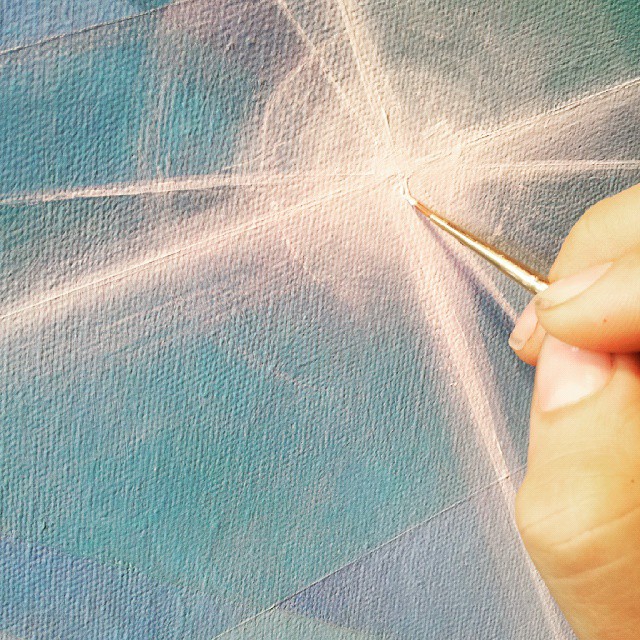
or... "What works and what doesn't"
In art as in life, there is no right and wrong, good and bad, etc. There is only what works and what doesn't. Just as in life, there is that which is incongruous to our spirits and that which is beneficial to a compositionally balanced life. Daily yoga works quite well. Daily drunkenness doesn't work very well at all. So we choose what works within the rhythm of life to the degree that it creates something balanced and harmonically correct. When we choose to engage Life in that act of co-creation we are asking it to allow us to to participate in that compositional choice.
Happy Accidents
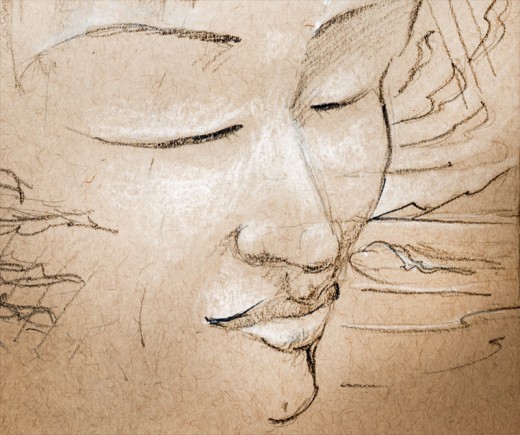
I assembled the stretcher bars to the desired size (18 x 14) and cut an appropriately sized rectangle of canvas. With pliers and staple gun I stretched it around the bars and then proceeded to gesso it. Once it appeared to be dry, I brushed on a background wash of yellow orange azo, burnt sienna, and a dash of dioxanine purple. But there was a several square inch spot in the middle of the bottom right corner that wasn't completely dry and so the wash picked up the gesso. This wasn't terrible in and of itself but it left a slight ridge between the original primed canvas and the freshly gessoed areas. I let it all dry and then went back and added more gesso to that area - creating a rather white sort of starburst on the yellow sienna background. After the gesso was dry I went back and washed over it with the original wash colors. Unfortunately this left sort of a lighter area under the final wash.
So turned the canvas upside down and suddenly it had the appearance of the sun setting behind a cloud bank. Magic. Perfect. And in just the right place....
Intentional Ambiguity Is Better Than Indecisive Vagueness
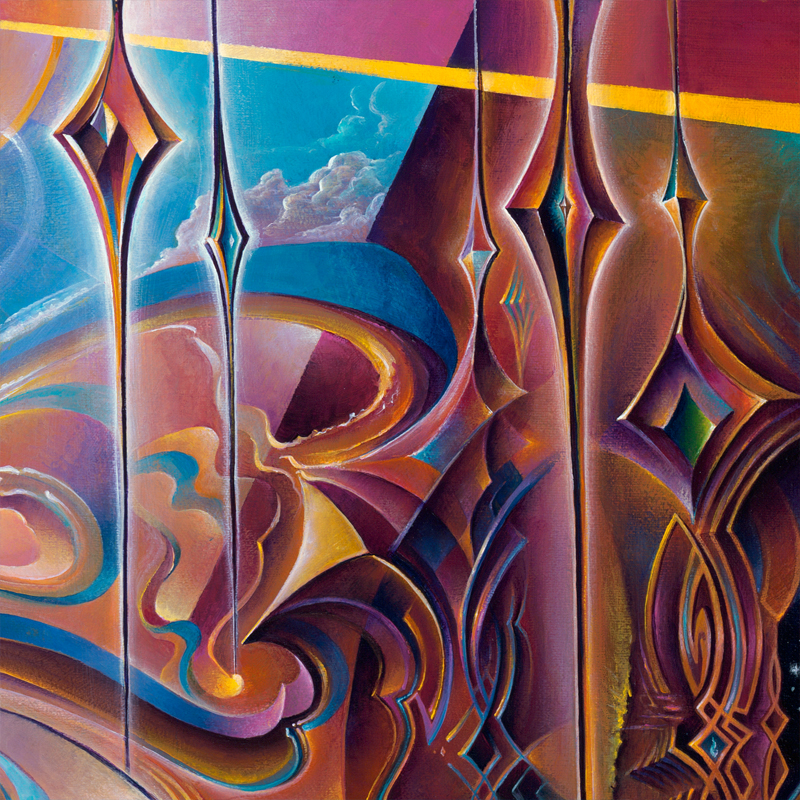
This is something I was thinking about while painting tonight. Often I leave things in my paintings rather ambiguous. Shapes are suggestive of animals or plants or clouds or structures. They are all inspired by countless things I see through the course of my days - the curve of the leaf of the plant in my garden or the arch of a cathedral I might happen upon. All of these things become part of the visual language and an artist can draw upon these shapes - even just the step of an edge or the clip of a curve - and use them to inform the work.
Now, the more you know - the more shapes and curves and lines and movements that you store in that visual memory - the more you can take your sense of 'I don't know what this is going to be' and simply shape it and allow it to take form and be informed by your visual memory and the feelings evoked by the different shapes you run across. Granted, it takes some practice to allow for the space to allow that through but with effort and practice (a sketchbook helps) you might find that this comes more easily than you realized.
Advice to Artists
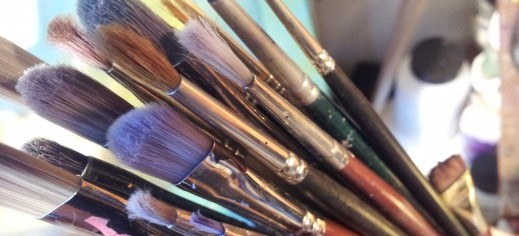
Ideas about art and business and creativity for young artists and old ones too but it's the young ones who ask...
- If someone wants to buy your art only hand it over when it has been paid in full
- Contracts are good. Get everything in writing when making a deal.
- For any commissioned work, always get at least half up front.
- It's ok to do things for free but don't give yourself away all the time. Your time is valuable.
- 'Exposure' is good but so is eating and paying the bills.
- Don't be afraid to say no when it comes to selling your art for less than you want for it.
- Trust yourself and know when to walk away.
- Selling art feels like you are being supported but just because you haven't sold anything lately doesn't mean you aren't any good.
- Even the most successful artists suffer from self-doubt. Just do your best.
- Your friends are usually terrible critics.
- Your partner should be your second biggest fan (second to YOU).
- You are good enough but you can always get better.
- Beware of tropes.
- Your best work will always be done when you're sober.
- Straight lines are best made with a ruler.
- A string, a tack or piece of tape, and a pencil will give you a perfect circle.
- If you see something in your painting that you want to change - change it. Otherwise, it will nag at you every time you look at the painting.
- Sit and draw people in real life. Don't just draw the pretty ones.
- If you wear headphones when you paint, invest in a good pair.
- Look for natural spectrum light studio lights - they will give you the best light.
- Make sure your studio has plenty of sunlight. Caves can be depressing to work in.
- A great painting takes time. Don't be afraid of taking the time.
- Love what you do and what you make.
- Practice makes perfect.
The Rule of Thirds and Composition
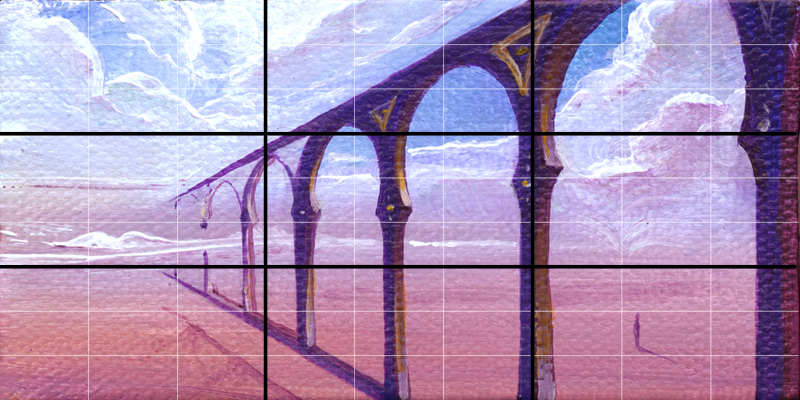
I'd like to talk about composition.
The Rule of Thirds is, I think, the best way to consider a composition. Using this little painting for an example - take a look at where the lines intersect the painting. It almost falls perfectly into it's respective sections. The right edge of the left third intersects the cloud opening and also the center of one archway. The left edge of the right third cuts through the column - balancing out the openings on the left. In the smaller thirds even, the small person falls in the middle third of the bottom right corner thirds. The lowest line of clouds, too, starts at the top of the bottom third of the painting and slowly drifts upwards. Between these and other details, the painting ends up falling into a nice order and feeling like a really balanced composition and ends up being more engaging and pleasing to the eye.
The Work Triad for Artists
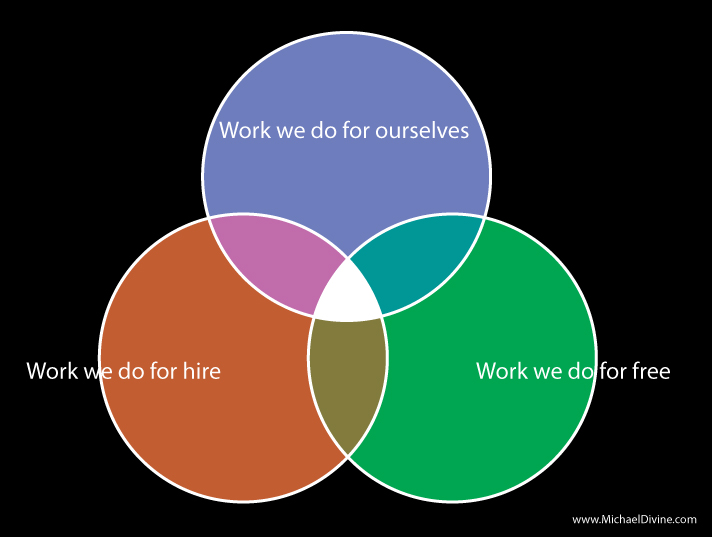
In my "career" as an artist (in quotes because when I was 20 it didn't seem so much a "career" as simply a need - a drive - a thing I was compelled to do) I've found that there's three main components of my work life:
- Work For Hire
- Work for Me
- Work for Free
We can never do any one of them all the time and remain happy and inspired. Instead we constantly cycle through them all. The quantity of time that we spend within each sphere is up to our own personal taste and need - some people find more satisfaction to weigh the scale heavier towards 'Work for Hire' while others towards the 'Work for Me.' And at times, the 'Work for Free' seems to take up TOO much time. However, all of them have their value and it is worth understanding how they support us.
Fonts (or HOW to say what you WANT to say)

Let's talk about fonts because HOW you say something is nearly as important as WHAT you are saying. Rhetoric - speaking and writing in a persuasive manner - goes far beyond simple word choice. Our choice of fonts in the branding of our message offers subtle clues to observers of how we think of ourselves, the kind of image we are want to portray, and the audience we hope to connect with. When we read a text, we are reading it in the tone the speaker wrote as much as the tone it is packaged in.
When choosing a font, some ideas to consider: